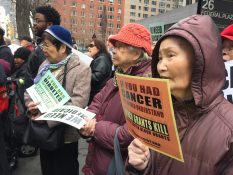Five years ago, emergency preparedness efforts failed people with disabilities during Hurricane Sandy.
Three years later, we won a court case against the City on disaster preparedness for people with disabilities (Emergency Preparedness Case Settlement Release). We’re taking a look at what’s changed.
In 2014, we negotiated with the City to improve emergency planning for people with disabilities. This was based on the Judge’s findings in the court order (Stipulation of Settlement and Remedial Order 2014). These negotiated commitments include:
- making 60 City shelters accessible for people with disabilities;
- devising a better accessible transportation plan so people with disabilities can evacuate safely before or after an emergency;
- providing accessible communications both in messages about emergencies and for materials in the shelters so people with disabilities can understand what is going on and what their options are;
- providing better canvassing so people with disabilities stuck in high rise buildings or in their homes after an emergency can get help, including evacuation help if needed; and
- developing a high-rise evacuation plan for people with disabilities so that those who can’t evacuate because of their disability can get help.
So – how is the City doing and what’s changed for people with disabilities? There is some progress.
But if another major storm or emergency happened today, many in our community may still not be able to get the help they need that is required by law.
By 2017, the City was required to make 60 shelters accessible and a plan for making the rest of the shelters accessible. The City now has 30 accessible shelters. They promise to have the other 30 accessible by September of 2018. There is no projection for when the rest of the shelters will be accessible.
For those who tried to evacuate but couldn’t get to an accessible shelter during Sandy, there is progress. The City’s 30 accessible shelters do have more accommodations and supplies for people with disabilities. These include priority charging stations for equipment, accessible cots, and refrigeration for medications. Shelters also have more information in accessible formats and wayfinding materials. Shelter staff and volunteers are being trained so that they are better aware of the needs of people with disabilities and how to provide accommodations. Yet, because there are only 30 accessible shelters citywide, getting to one of them nearby still may be difficult, if not impossible, for many.
The City’s accessible transportation plan was due in August 2017. We’re still waiting.
Will there be accessible transportation to get people to accessible shelters or to families and friends if an emergency happens today? What changed for people who waited at a bus stop during Sandy only to see accessible buses pass them by because they were full? Or who stayed at home because accessible transportation was shut down early and they couldn’t get out? We still don’t know if the City has enough accessible transportation for those who need it. Or if there’s an efficient plan to provide it or drivers trained to help people with disabilities.
Canvassers help those who need to evacuate after the event or who need to get to critical medical appointments like dialysis. The City’s canvassing plan needed updating to help people with disabilities. People may need accommodations and/or supplies directly after an emergency so they can stay safely in their homes. Thankfully, the City’s plan includes a more timely response than they had for Sandy. Canvassers are better trained in accommodating people with disabilities. But it’s still unclear how canvassers will be able to help many people with disabilities. For example, those who cannot get to the door, who cannot stand long enough to answer the survey questions, those who are Deaf or who are blind, and people who have difficulty understanding what’s going on.
A high rise task force was developed to provide evacuation and transportation plans for people with disabilities in high rise buildings. This could be before or after an emergency.
We are waiting to see a plan that includes how people with disabilities will get help evacuating safely before an emergency. We don’t know what accessible transportation will be available for them. Or how they will leave with their equipment, service animals, and such. We also have not seen a plan for how they will get home after the emergency and power is returned to their buildings.
We are concerned that nothing much has changed in emergency preparedness for people with disabilities. People were stuck in their homes during Sandy because the power went out, because they couldn’t transfer out of their apartments without help, or because they couldn’t get to accessible transportation in time to evacuate.
We agree that people should try to prepare for emergencies as they can. But many New Yorkers with disabilities also live in poverty. They are not able to prepare in the way the City suggests: they cannot stockpile extra equipment, food, water, or medication. Many do not have family or friends in accessible apartments or homes that they can stay with during an emergency. Many are isolated and may not be able to reach out to neighbors. They need the City to help them have an equal opportunity to survive an emergency, just like anyone else. The City has made some progress, but we still have a way to go.
CIDNY continues to watch and comment on the City’s progress. If you want more information on the progress of emergency planning for people with disabilities, please contact info@cidny.org.




